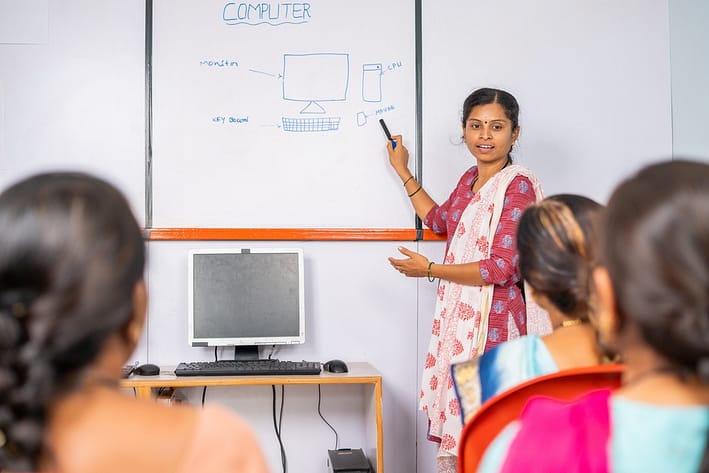Skill India Digital Hub: Empowering India’s Digital Workforce
1. Introduction
Digital India finds its way into Skill India Digital given that every learner with a cell phone can get access to education, certification, jobs, and entrepreneurship. The whole thing is an entire constellation of possibilities, convenience, and powerful learning. This initiative stands as evidence that the government developed SIDH (Skill India Digital Hub) to ascertain digital skilling is within everyone’s reach.
SIDH is a skill ecosystem at the national level. It serves as a one-stop centralized hub for learners, educators, employers, and trainers. Its directly connects the citizens to skill courses, certifications, jobs, apprenticeships, and entrepreneurship schemes. It integrates government, private, and CSR training programs to bring all of these under one digital roof.

This blog walks you through how SIDH originated, what it offers, how it impacts India’s workforce, where it stands today, and why it shapes the nation’s future. This becomes your guide to understand the initiative and explore opportunities in India’s evolving digital economy.
2. The Birth of Skill India Digital Hub (SIDH)
SIDH is being poured into the Digital Public Infrastructure for Skills, Employment, and Entrepreneurship by the Government of India. It has at its core an ecosystem of stakeholders, including various ministries, private sector companies, learners, and educators. It integrates capacity-building schemes such as PMKVY, PMVK, and PMKK and job-oriented learning so that the two can complement each other.
In August 2024, SIDH was put into action as a culmination of the government’s desire to further its vision of making skill development, accessible, transparent, and outcome-driven. The Ministry of Skill Development and Entrepreneurship controls the platform.
3. Core Objectives of SIDH
- Provide digital access to skill development across India.
- Offer anytime/anywhere, industry-aligned courses.
- Integrate government, CSR, and private training ecosystems.
- Enable recognized certification and digital CVs.
- Linking training to experience through jobs and apprenticeships.
- Enable entrepreneurial initiatives and nurture microbusinesses.
4. Key Features that Empower Users
- Mobile-first design: Learners access courses in multiple Indian languages.
- Digital CV & QR codes: The platform builds resumes and recruiters capture QR codes.
- AI Recommendations: Learners receive personalized course recommendations.
- Unified Skills Map: Users search for skill centers and jobs via geo-location.
- LMS integration: Tracks progress, stores eBooks, and supports discussion forums.
- Scheme convergence: Merges eKYC, DigiLocker, eShram, NAPS, and more.
5. Major Partners and Collaborations
SIDH collaborates with:
- Sector Skill Councils
- Microsoft, Cisco, HCL, Coca-Cola, Infosys
- IGNOU, UpGrad, Tutorials Point
- State governments such as Karnataka and Andhra Pradesh
- Some government programs include PMKVY, PMKK, and UdhyamKart.
6. User Experience: How It Works
Users register using mobile or Aadhaar. They complete eKYC. They choose from a wide range of courses and They track progress in real time. The app builds a digital resume. Employers and job seekers interact directly. Skill centers offer physical support for those who need it.
7. Success Stories and Testimonials
Tens of thousands have completed certification through SIDH. Youth in rural India report better job opportunities. Employers say SIDH makes hiring easier. Government data show rising placement rates through SIDH-supported programs.
8. Comparing SIDH with Other Platforms
- SWAYAM: University-level MOOCs; SIDH focuses on practical job skills.
- CSCs: Provide access points; SIDH offers full digital training and certification.
- DIKSHA: Teacher training; SIDH supports broader job and business skills.
SIDH stands out for its integrated ecosystem and real-time tracking.
9. Challenges and Criticisms
Users in remote areas face internet issues. Some report delays in certification. Rural digital literacy remains low. Language barriers still exist. SIDH needs better offline access and multilingual support. These gaps may affect the most vulnerable learners.
10. Future Roadmap
- Add AI, drone, and EV courses.
- Expand content in regional languages.
- Improve offline availability.
- Build stronger employer partnerships.
- Monitor and upgrade ITIs and digital centers.
The government is working on continuous upgrades to address these needs.
11. Conclusion
SIDH reshapes India’s skilling landscape. It gives learners control. It connects education with employment. Its support entrepreneurs and gig workers. It strengthens Digital India’s foundation. SIDH is not just a platform—it’s a national movement for skill empowerment. If you haven’t explored it yet, now is the time to do so.



0 Comments